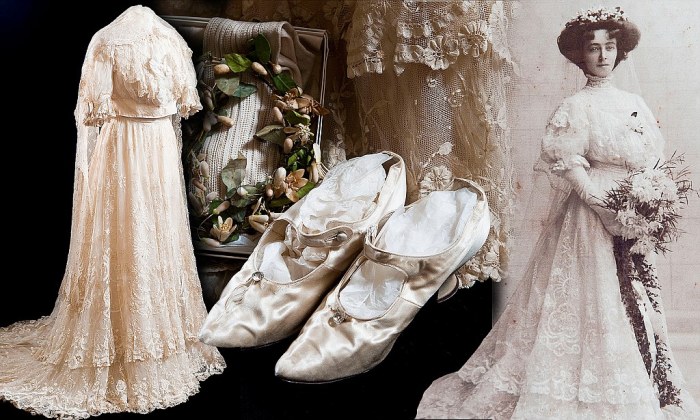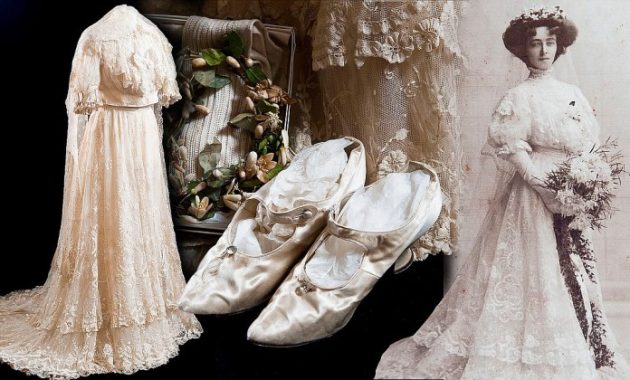Defining the Edwardian Era in Wedding Dress Design
Edwardian inspired wedding dress – The Edwardian era, spanning from 1901 to 1910, witnessed a distinct evolution in fashion, significantly impacting wedding attire. This period saw a shift from the restrictive styles of the Victorian era towards a more streamlined and elegant aesthetic, reflecting the changing social and cultural landscape.
Edwardian-inspired wedding dresses offer a touch of vintage elegance, perfect for a bride seeking a refined aesthetic. The choice of gown often depends on the setting; for a civil wedding, consider the formality of the venue. Finding the perfect dress is simplified by browsing resources like this guide on dress for a civil wedding , which can help you navigate various styles.
Ultimately, an Edwardian-inspired dress can be a stunning choice for a civil ceremony, providing a unique and sophisticated look.
Key Characteristics of Edwardian Wedding Attire
Edwardian wedding dresses are characterized by their emphasis on a defined waistline, often achieved through corsetry, flowing skirts, and delicate embellishments. The use of luxurious fabrics like silk, lace, and satin was prevalent, reflecting the affluence of the era. A preference for lighter colours, such as ivory and cream, replaced the darker shades popular in the Victorian era.
The silhouette transitioned from the fuller, more elaborate gowns of the late Victorian period towards a more slender, elegant form, though variations existed throughout the decade.
Evolution of Wedding Dress Styles (1901-1910)
Early Edwardian gowns retained some Victorian influences, featuring a full, long skirt and a defined waist. As the decade progressed, the S-bend silhouette emerged, emphasizing a dramatic curve at the waist and hips, achieved through corsetry and clever tailoring. By the late Edwardian period, a move towards simpler lines and a more streamlined silhouette was apparent, though elaborate embellishments remained.
Comparison with Preceding and Succeeding Eras
Compared to the Victorian era, Edwardian wedding dresses were generally less voluminous and more form-fitting, with a greater emphasis on creating a defined waistline. In contrast to the looser, more flowing styles of the 1920s, Edwardian gowns maintained a structured silhouette, emphasizing the figure through corsetry and tailoring. The use of elaborate lace and embellishments also distinguished Edwardian gowns from the simpler designs of the later era.
Typical Fabrics, Silhouettes, and Embellishments

Source: co.uk
| Fabric | Silhouette | Embellishments | Example |
|---|---|---|---|
| Silk | S-bend | Lace | A flowing silk gown with an accentuated S-bend waist and delicate lace detailing at the bodice and sleeves. |
| Satin | Empire waist | Beading | A satin gown with a high empire waistline and intricate beading patterns throughout. |
| Lace | A-line | Ribbon | A lace gown with a more relaxed A-line silhouette, adorned with satin ribbons. |
| Crepe | Sheath | Embroidery | A crepe gown with a close-fitting sheath silhouette and subtle embroidered floral motifs. |
Silhouette and Structure of Edwardian Inspired Wedding Dresses
The silhouettes of Edwardian-inspired wedding dresses are defined by their emphasis on the waistline and the overall shape of the gown. The use of corsetry and specific tailoring techniques are crucial in achieving these iconic shapes.
Common Silhouettes and Their Construction, Edwardian inspired wedding dress
The S-bend silhouette, characterized by a dramatic inward curve at the waist and a pronounced outward curve at the hips, was a hallmark of the Edwardian era. This was achieved through the use of tightly laced corsets, often combined with boning and padding to create the desired shape. The hobble skirt, a narrow, ankle-length skirt that restricted movement, was another popular style, emphasizing a slender silhouette.
These silhouettes were created through careful tailoring and the strategic use of fabric to create the desired drape and form.
Three Edwardian-Inspired Silhouettes
Here are three distinct Edwardian-inspired silhouettes, each with unique features:
- The Classic S-Bend: A fitted bodice emphasizing a dramatic S-bend curve at the waist, flowing into a full, ankle-length skirt. This silhouette is achieved through corsetry and boning to shape the bodice and create the dramatic curves.
- The Empire Waist: A high-waisted gown with a flowing skirt, creating a more relaxed and less restrictive silhouette than the S-bend. This style offers a softer, more romantic look.
- The Princess Line: A long, flowing gown with a fitted bodice that falls smoothly into the skirt, creating a sleek and elegant silhouette. This style emphasizes vertical lines and a streamlined shape.
Modern Adaptations of Edwardian Silhouettes
- Many contemporary designers incorporate the S-bend effect through clever draping and seaming, avoiding the restrictive nature of traditional corsetry.
- The empire waistline remains a popular choice for modern brides, offering a comfortable and flattering silhouette.
- The princess line silhouette is frequently adapted, offering a streamlined, elegant look that is both modern and timeless.
Fabrics and Embellishments in Edwardian Inspired Wedding Dresses
The choice of fabric and embellishments significantly contributed to the luxurious and elegant aesthetic of Edwardian wedding gowns. The era favoured high-quality materials and intricate detailing.
Common Fabrics and the Significance of Lace
Luxurious fabrics such as silk, satin, and fine wool crepe were commonly used. Lace, however, played a particularly significant role, adding a layer of delicacy and sophistication. Various types of lace, including Chantilly, Alençon, and Irish crochet, were incorporated into gowns, often as accents on the bodice, sleeves, or hemline. The intricate patterns and delicate textures of the lace enhanced the overall elegance of the dress.
Traditional and Modern Embellishments
Traditional embellishments included beading, embroidery, and delicate ribbon work. These techniques were used to add intricate detail and texture to the gowns. Modern interpretations often incorporate these elements, sometimes using them more sparingly for a more understated elegance.
List of Fabrics and Embellishments
- Silk: A luxurious, flowing fabric with a smooth, lustrous texture. It adds a sense of opulence and elegance.
- Satin: A smooth, shiny fabric with a rich sheen. It creates a sleek and sophisticated look.
- Lace (Chantilly, Alençon, Irish Crochet): Delicate and intricate, adding texture and visual interest.
- Beading: Adds sparkle and texture, creating intricate patterns.
- Embroidery: Adds delicate detail and texture, often featuring floral motifs.
- Ribbons: Adds a touch of romanticism and delicate detail.
Accessories and Details of Edwardian Inspired Wedding Dresses
Accessories played a crucial role in completing the Edwardian bridal look, adding further elegance and sophistication to the overall ensemble. Hats, veils, and gloves were essential components.
Typical Accessories and Veil Styles
Hats were often worn, ranging from small, feathered creations to larger, more elaborate styles. Veils were also integral, often featuring delicate lace or tulle, cascading down the back or framing the face. Gloves, usually long and made of delicate materials such as silk or lace, completed the look.
Three Edwardian-Inspired Headpiece Options
- A small, feathered hat adorned with delicate flowers or jewels, perched atop the head.
- A long, flowing veil made of delicate lace, cascading down the back.
- A simple, elegant headband embellished with pearls or small gemstones.
A Complete Edwardian-Inspired Bridal Look
An ivory silk gown with an S-bend silhouette, featuring intricate Alençon lace detailing on the bodice and sleeves. A long, flowing tulle veil cascades down the back, complemented by long silk gloves and a small, feathered hat adorned with pearls. The hair is styled in a soft updo, adorned with delicate flowers.
Modern Interpretations of Edwardian Inspired Wedding Dresses
Contemporary designers often draw inspiration from the Edwardian era, incorporating key elements into modern wedding gowns while adapting them to suit contemporary tastes and styles.
Comparison of Traditional and Modern Interpretations
While modern interpretations retain the elegance and sophistication of Edwardian designs, they often incorporate more comfortable fabrics and construction techniques. The restrictive corsetry of traditional Edwardian gowns is often replaced by more modern methods of shaping the silhouette, such as strategic seaming and draping.
Incorporating Edwardian Elements into Contemporary Gowns
Modern designers achieve this by using modern fabrics while maintaining the essence of Edwardian elegance. This can involve incorporating lace detailing, high necklines, long sleeves, or the use of flowing fabrics that evoke the silhouette of the era.
Examples of Modern Edwardian-Inspired Wedding Dresses
- A flowing silk gown with a high neckline and long sleeves, featuring delicate lace appliqués and a subtle empire waistline.
- A crepe gown with an A-line silhouette, incorporating beading and embroidery details inspired by Edwardian designs.
- A satin gown with a fitted bodice and a full skirt, featuring a modern take on the S-bend silhouette through strategic draping.
Illustrating Edwardian Inspired Wedding Dresses
High Neckline, Long Sleeves, Intricate Lace
This gown features ivory silk crepe with a high neckline, long sleeves, and intricate Alençon lace detailing across the bodice and cascading down the skirt. The silhouette is a modified A-line, achieving a modern elegance while retaining the graceful drape of an Edwardian gown. Delicate pearl beading accents the lace.
Fitted Bodice, Full Skirt, Delicate Beading
This design utilizes a luxurious satin fabric in a creamy white hue. The fitted bodice, cinched at the waist, flows into a full, slightly gathered skirt. Delicate seed beading creates a subtle shimmer across the bodice and extends to the top of the skirt, adding a touch of sparkle without overwhelming the elegance of the silhouette. The back features a delicate lace overlay.
Dropped Waist, Flowing Skirt, Subtle Embroidery
This gown showcases a soft, flowing silhouette with a dropped waistline. The fabric is a lightweight silk chiffon in a pale ivory shade. Subtle floral embroidery in a muted silver thread adorns the bodice and continues down the skirt in a delicate pattern, adding a touch of understated romance. The sleeves are long and slightly gathered at the cuffs.
Key Questions Answered
What is the difference between an Edwardian and a Victorian wedding dress?
Victorian dresses (1837-1901) tend to be more voluminous and ornate, often featuring a fuller skirt and more elaborate embellishments. Edwardian dresses (1901-1910) are generally more streamlined and less fussy, emphasizing a more defined waist and a sleeker silhouette.
Are Edwardian-inspired dresses comfortable to wear?
Modern interpretations often prioritize comfort. While traditional corsetry was restrictive, contemporary designers use techniques to achieve the desired silhouette without sacrificing comfort. Fabrics and construction methods are adapted for modern wear.
Where can I find an Edwardian-inspired wedding dress?
Many bridal boutiques offer custom designs or carry lines inspired by Edwardian styles. Online retailers and vintage shops may also offer options, though alterations may be necessary.
How much does an Edwardian-inspired wedding dress typically cost?
The cost varies greatly depending on the designer, fabric choices, embellishments, and level of customization. Prices can range from several hundred to several thousand dollars.

